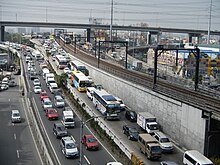The Magallanes Interchange is a four-level partial turbine interchange in Makati, Metro Manila, Philippines. It serves as the junction between the Osmeña Highway, Epifanio de los Santos Avenue (EDSA), and South Luzon Expressway (SLEX), intersecting with inner streets and Chino Roces Avenue as well.[1][2] It is also an interchange between the two train lines of Metro Manila, the MRT-3, which is over EDSA, and the PNR Metro Commuter Line beside Osmeña Highway and SLEX. It is currently one of the busiest intersections in Metro Manila.
| Magallanes Interchange | |
|---|---|
 The Magallanes Interchange in 2014 | |
 | |
| Location | |
| Makati, Metro Manila, Philippines | |
| Coordinates | 14°32′25.54″N 121°1′0.74″E / 14.5404278°N 121.0168722°E |
| Roads at junction | |
| Construction | |
| Type | Four-level partial turbine interchange |
| Opened | 1975 |
| Maintained by | Department of Public Works and Highways |
History
editAfter the proposal of President Ferdinand Marcos in 1969 to create six circumferential roads, EDSA, which used to end at Taft Avenue (Manila South Road), was extended to Roxas Boulevard. Thus, an interchange was required between the then-newly built Manila South Diversion Road and EDSA. It opened in 1975 officially as the Manila South Diversion Road–EDSA Interchange.[3][4]
In 1993, more lighting facilities were installed at the interchange by an ordinance ratified by the Makati local government. The interchange underwent redevelopment and beautification by the Makati local government in 2005,[5] thus opening a park at the interchange's ground level.
Traffic management measures
editThe interchange's elevated left-turn portion from Osmena Highway southbound onto EDSA northbound is indefinitely closed as a measure against traffic congestion and accidents in the area.[6] In addition, the portion of Chino Roces Avenue passing beneath the interchange's flyovers along EDSA is designated as one-way northbound, with a vertical clearance of 2.70 meters (8.9 ft). Southbound traffic for that section of Chino Roces is redirected to EDSA's at-grade service road.[7]
Feared collapse and rehabilitation efforts
editThe interchange was poorly designed as it had prior damages on the carriageway, particularly cracks and disintegration of concrete, guard rails, and steel expansion joints. Having been repaired in the 1980s, it was one of the most priority structures in Metro Manila that needed retrofitting.[8]
In November 2010, several pipe leaks were discovered under the interchange, leading to the closure of its outer lanes by the Metropolitan Manila Development Authority due to fears of compromised structural integrity; it was reopened in 2011.[9]
The strengthening works at the interchange were completed in 2017.[8] The interchange's flyover is set for rehabilitation starting in October 2024.[10]
References
edit- ^ "Road and Bridge Inventory". Department of Public Works and Highways. Retrieved August 9, 2021.
- ^ "Metro Manila 2nd". www.dpwh.gov.ph. Retrieved November 7, 2018.
- ^ Castro, Alex (September 12, 2017). "These Photos of Makati From the Past Will Amaze You". Spot.ph. Retrieved October 10, 2021.
- ^ Presidential Decree No. 1062 (December 15, 1976), Appropriating Funds for Infrastructure Development, Synchronizing the Same with Previous Public Works Appropriations, retrieved December 31, 2021
- ^ "Resolutions and Ordinances: Infrastructure". Makati Web Portal. Retrieved March 20, 2022.
- ^ "Part of Magallanes Interchange closed indefinitely". The Philippine Star. April 1, 2019.
- ^ "2260 Chino Roces Ave" (Map). Google Maps. Retrieved May 8, 2024.
- ^ a b "DPWH Completes Strengthening Works at Magallanes Interchange". Department of Public Works and Highways. June 22, 2017. Retrieved January 10, 2022.
- ^ "FPIC pipe leak traced to 5 holes near Magallanes flyover". GMA News Online. 2010-11-08. Retrieved May 17, 2024.
- ^ Cabalza, Dexter (May 24, 2024). "MMDA moves Magallanes flyover rehab to October". Philippine Daily Inquirer. Retrieved May 24, 2024.